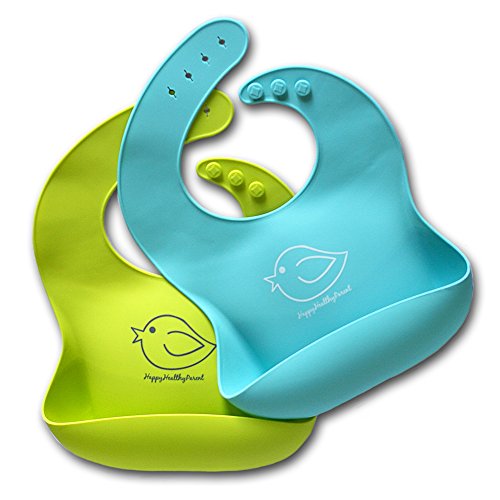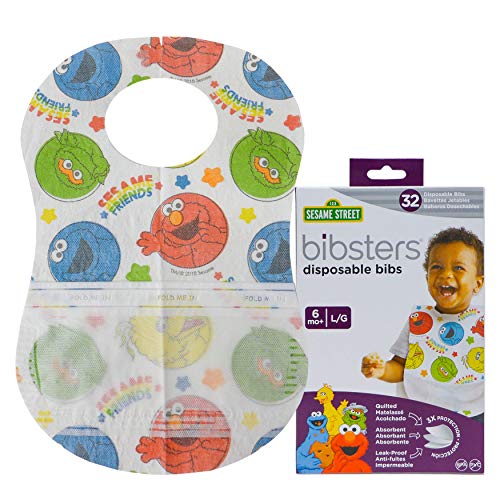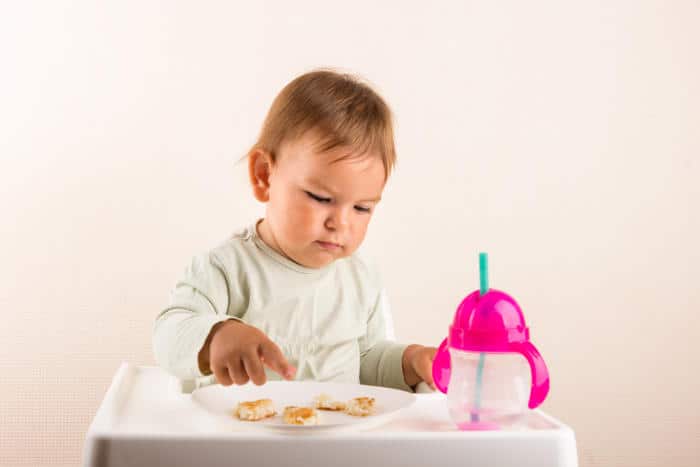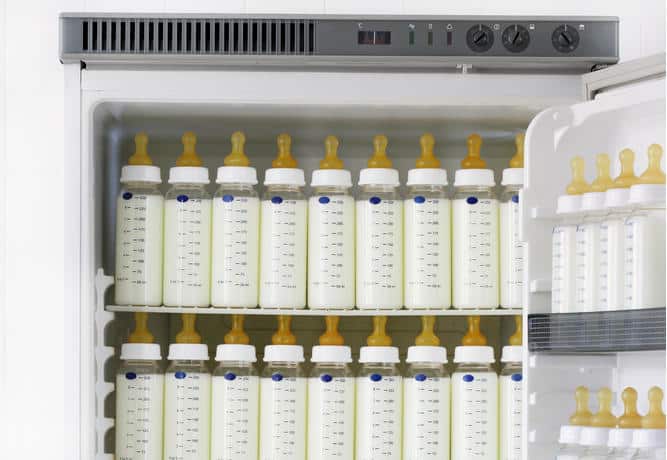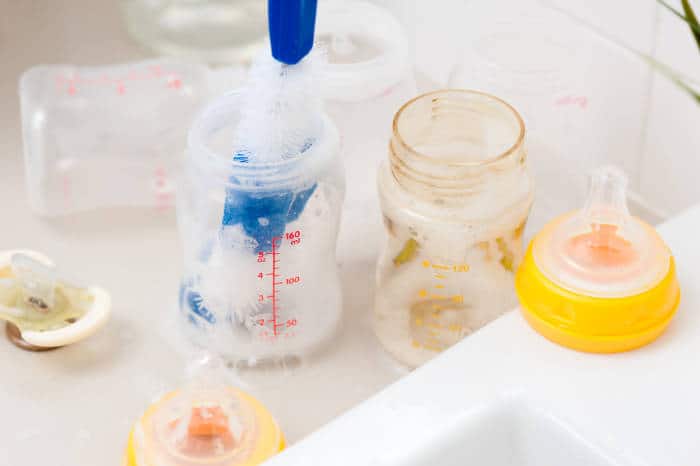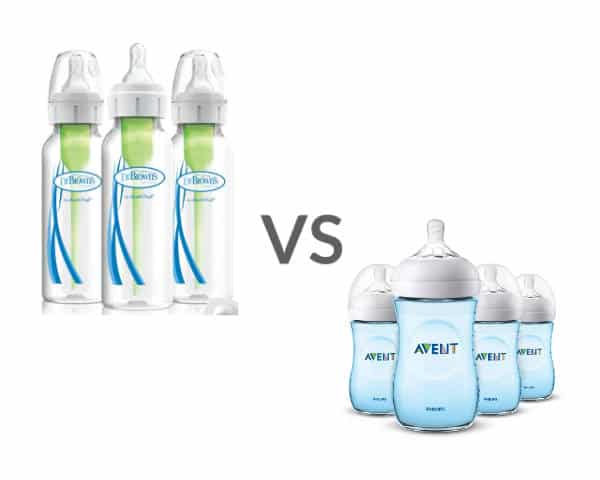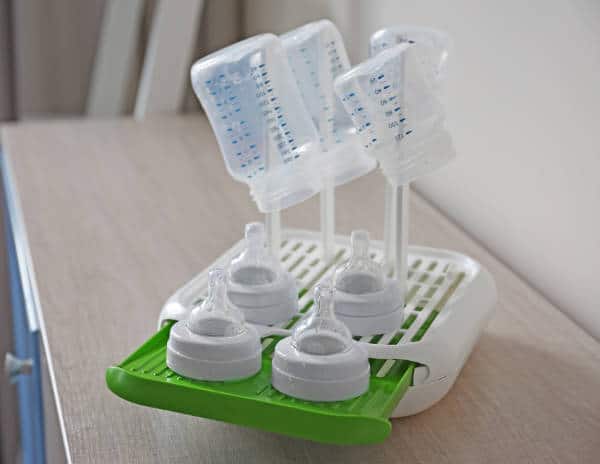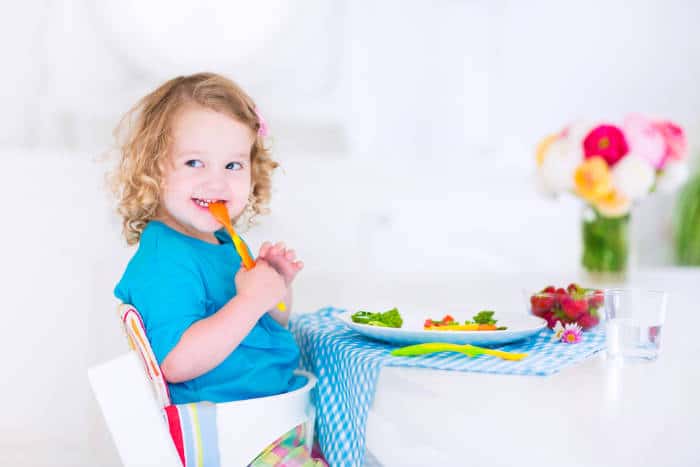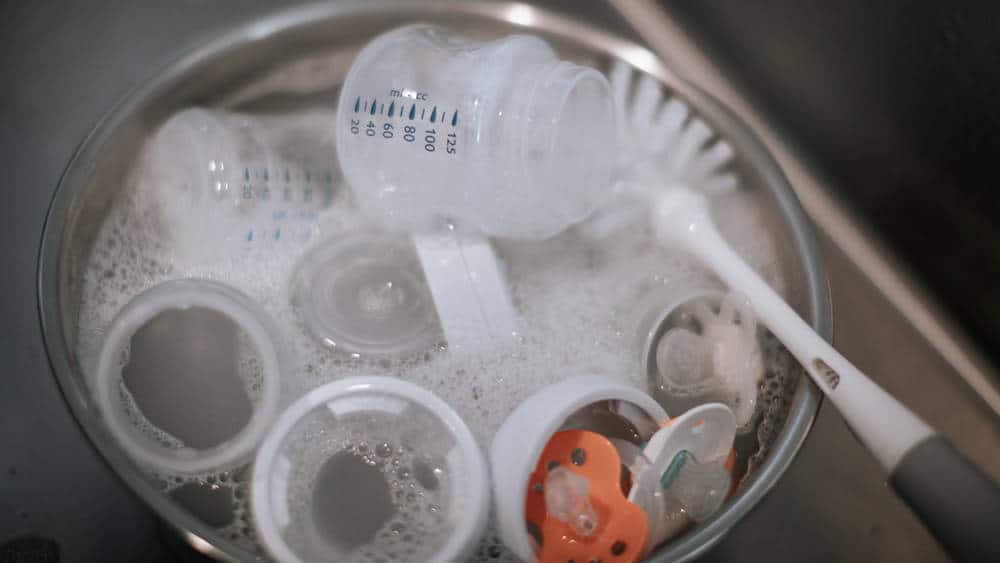When shopping for babies, many supplies top the list. Everyone remembers sleepers, diapers, wipes, diaper rash cream, etc. Sometimes, however, crucial baby gear gets left behind and forgotten until you’re covered in spit up (or worse) and desperately reaching for something to wipe it up.
Baby bibs may not top the biggest baby lists sometimes, but they are certainly useful in the early days and beyond as your baby grows and develops into an even bigger “mess maker”. Plus, can you really turn down an opportunity to further accessorize those cute outfits that they outgrow within the blink of an eye?
That’s why we’ve broken down the 411 on types of baby bib and when/why they’re helpful for busy parents, complete with the pros and cons of each!
The Best Baby Bibs – Our Picks
- MatiMati Bandana Drool Bibs – Overall best baby bibs – Soft bandana style perfect for newborns and drool factories
- Baby Bandanas with Teethers – Best baby bib with a teether – Comfy and absorbent
- Bumkins Waterproof – Best waterproof baby bib with a hook & loop enclosure
- Happy Healthy Silicone Baby Bibs – Food grade silicone baby bibs that are dishwasher safe
- Hi Sprout Sleeved Bibs – Full smock baby bib that offers waterproof protection
- Bibsters Disposable Baby Bibs – Best baby bib for meals on the go, made from disposable paper
Note: Our individual reviews are below, but you can also click any of the links above to check current prices on Amazon and other retailers
Table of Contents
Baby Bib Reviews
MatiMati Bandana Drool Bibs
Are you raising a baby fashionista? These baby bibs are cute and functional. They’re soft and absorbent with a polyester fleece lining to soak up drool and spit up. They fasten with snaps to eliminate the possibility of scratchy Velcro irritating your baby’s skin
These drool bibs also happen to come in a set, giving you more bang for your buck. Coming in a variety of prints as well, these are a cute option to showcase your (and your baby’s) fun personality.
Overall, these bandana bibs hold up well with use but do have the tendency to fade with repeated washes.
What we liked:
- Soft and comfortable on baby’s neck
- No scratchy Velcro
- Absorbent fleece backing liner
What we didn’t:
- Some fading in the wash
Baby Bandanas with Teethers
This design is fairly comparable to other bandana baby bibs on the market, but they feature a soft teether intended for infant’s 10 months or younger.
Utilizing a cotton layer on the front and polyester fleece backing, these bibs are suitable for machine wash. However, bibs and teethers should be cleaned separately. Teethers are safe for dishwasher sanitization. These bandana bibs also utilize snaps rather than Velcro.
These baby bibs also come in a set of 6 with stylish prints for boys and girls. Colors shown in photos may be slightly different in person though.
What we liked:
- Soft material
- Easy-to-fasten snaps
- Teether attached to minimize dropping
- Easy to clean
What we didn’t:
- Colors may be different in person
Bumkins Waterproof
For older infants, these waterproof baby bibs could be a great choice for feeding time. More food equals more mess after all. They’re designed to fit baby’s from 6-24 months and can be used for quite a while in the scope of babyhood (Not many products can say that. Talking to you cute sleeping onesies in size “newborn”)
As an adjustable feature, these bibs fasten with a hook and loop enclosure. They also offer the convenience of a pocket to catch food before it hits the floor (well, what baby doesn’t chuck across the room like a pro baseball player).
The material is single ply and is designed to prevent germs from growing between multiple layers of fabric. Bumkins baby bibs also feature BPA and PVC free construction and still retain their easy-to-clean status. Although machine washable, it’s advised to line dry these to avoid heat damage to the waterproof material.
What we liked:
- Transitions through stages with baby
- Waterproof material
- Pocket to catch food
- BPA/PVC free
- Button enclosure
What we didn’t:
- Waterproof material can peel if wash directions aren’t followed
Happy Healthy Silicone Baby Bibs
Similar to other feeding bibs on the market, Happy Healthy Baby Bibs are constructed with a helpful pocket to catch rogue food particles and droplets. These are made with food-grade silicone and are therefore waterproof and easy to clean no matter the mess.
These silicone bibs are easy to fasten with adjustable buttons that grow with your child which makes them perfect for the baby to toddler transition. They’re also easily rolled up for diaper bag storage and toting.
These simple but cute bibs also come in a set of two with four bright color combinations. An added measure of convenience, these bibs are actually dishwasher safe.
What we liked:
- Waterproof
- Front pocket
- Adjustable enclosure
- Dishwasher safe
- Food grade silicone bib
What we didn’t:
- Buttons may be tricky to fasten compared to Velcro or traditional snaps
- The fit around the neck might not be as snug
Hi Sprout Sleeved Bibs
For even more protection of those precious baby outfits, a smock bib like Hi Sprout could be a good choice. These long sleeve options are waterproof and BPA, PVC, lead, phthalate, and vinyl free. They even feature a pocket like popular feeding bib options.
These are machine washable and fasten with convenient Velcro. They’re suitable for ages 6-24 months and could be useful for multiple activities outside of eating (hello finger painting, talking to you!), Hi Sprout Sleeved Bibs also come in a wide variety of colors and patterns.
What we liked:
- Full coverage and outfit protection
- Helpful pocket
- Variety of designs
- Machine washable
- Transition for baby to toddler
What we didn’t:
- Material has tendency to grow mold if not washed and cared for promptly
- Questions about stitching quality
Bibsters Disposables
Unlike the wipeable silicone baby bib, the polyester smocked bib, or the cuddly cloth bandana baby bib, these Bibsters are a convenient toss & go option. If you don’t like the idea of a full cleanup or tossing the mess in your bag while out and about, these could be a sound option.
They’re made from an absorbent quilted material and still retain the useful pocket to catch stray bites of food.
However convenient, these are easier for babies to tear off mid-meal. Issues with proper fit may arise with younger infants as well.
What we liked:
- Disposable
- Absorbent material
- Pocket for catching food
- Convenient for restaurants and travel
What we didn’t:
- Easy for babies to remove
Types of baby bibs
No, a lobster bib won’t cut it. As cute as that sounds, babies would much rather wear some of the cute alternatives we’re going to show.
Why do baby bibs matter might you ask? Let’s just put it this way…The amount of laundry you’re about to add to your household is exponential. Catching some of the mess on a bib versus changing them into an entirely new outfit can save you time and sanity.
Bandanas/drool bibs
These are the soft and equally comfortable designed bibs you often see on newborns up to older infants that are still not eating solid food yet. They’re main function is to catch any spit up your baby has.
Spit up has a habit of collecting under the baby’s chin and neck and can lead to irritation. So, it’s best to try and keep that area dry because baby skin is especially sensitive. If your baby suffers from a touch of acid reflux, prepare for even more spit up!
Burp cloths
These aren’t bibs, but they’re just as handy for new babies. Burp cloths are absorbent “towels” that can be used to wipe spit up or catch it during burping. They don’t go around the baby’s neck at all but are more for use “wherever they’re needed.”
They’re convenient to throw over your shoulder while burping upright, or you can carefully place under your baby’s chin as you set them on your lap to burp.
Standard feeding bibs
Feeding bibs are generally the same cut and fasten around the neck with Velcro or snaps. Sometimes, feeding bibs are made from easy-to-clean fabric. However, the most defining feature is the handy pocket sewn onto the bottom of the bib.
This catches chunks of solid or drips of puréed food before they hit the floor, therefore lightening the load for whoever is in charge of cleanup. (Cue happy dance if the bib happens to catch it all!)
Bibs with full fronts and sleeves (smock style)
Smocked bibs are somewhat reminiscent of some painting smocks and are basically aprons with long sleeves. They protect your child’s entire outfit and are helpful for keeping nice clothes free from stains. Don’t worry about smearing food when removing because they have an open back.
How many bibs will I need?
The number of baby bibs needed for various stages correlates with their eating habits. Most babies will need bandana/drool bibs until around four months when they can transition to eating solid food and will then need a feeding/smock style bib.
Generally speaking, 4-6 bibs is okay to start out with in each stage. You’ll get a grasp for how many you need from there and if your baby suffers from reflux, you’ll undoubtedly end up buying a few more.
Now for burp cloths, it’s a safe bet to double that number and get at least 10-12. You’ll go through MANY of these. Just trust us! They’re convenient for cleaning up spit up, spilled milk, and even runny noses in a pinch. If you’re “nap trapped” under a sleeping baby, having one of these at arm’s reach is a lifesaver for messes.
What size is my baby’s neck?
Average size charts suggest your baby’s neck will fall within the range of 8-10 inches from newborn to 12 months. As they reach toddler age they may jump up a bit to 10-12 inches.
Do newborns need bibs?
You may question the need for newborn bibs when the baby is fairly inactive and food consists solely of breastmilk or formula, but rest assured both of those liquids tend to find themselves down the front of their sleeper or your t-shirt. So, yes, it’s a good idea to throw on a bib.
Newborns don’t need baths every day and using a bib to keep milk from getting into the delicate skin of their neck creases is a good idea to avoid irritation and rashes. Plus, breastmilk tends to leave a stain on your baby’s clothes. If you have any plans to resell or consign outfits, it could be a good idea to protect them with a bib.
What’s the best fabric type for a bib?
Of course everyone has seen cotton bibs. They’re soft and cuddly just like the squishy babies that wear them. However, baby gear has come a long way since our parents were raising us and they probably would have fallen out of their chairs seeing how convenient gadgets (even bibs!) have made certain aspects of parenting.
A baby bib can get messy. That’s the point. If you’re out at a restaurant or traveling, it might not be convenient to toss a filthy bib back into your diaper bag or travel tote. A handy solution could be paper disposable bibs. They may not be the economical choice for everyday use, but for use in a pinch, they could be a useful hack for being out and about with your baby.
If you’re hesitant to spring for anything in the realm of rubber or plastic bibs, there are safe BPA free silicone options for feeding bibs. They’re easy to clean and quick to dry. These can be great for use at home or out and about. A quick dump of any lingering food in the pocket and a wipe down with a wet wipe, and you’re ready to go.
There are also varieties of neoprene baby bib on the market, which are soft and flexible for wear. However, material-conscious parents may feel hesitant to use neoprene around their baby. The consensus is that unless you have a concern about a neoprene allergy, wearing the material is generally safe. You can also opt for cloth bibs. The most concern comes from the production of the fabric and not wearing the neoprene itself.



